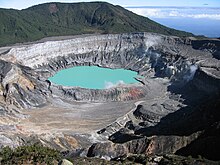

Tourism in Costa Rica has been one of the fastest growing economic sectors of the country[2] and by 1995 became the largest foreign exchange earner.[3][4] Since 1999, tourism has earned more foreign exchange than bananas, pineapples and coffee exports combined.[5] The tourism boom began in 1987,[3] with the number of visitors up from 329,000 in 1988, through 1.03 million in 1999, over 2 million in 2008, to a historical record of 2.66 million foreign visitors in 2015.[6][7] In 2012, tourism contributed with 12.5% of the country's GDP and it was responsible for 11.7% of direct and indirect employment.[8] In 2009, tourism attracted 17% of foreign direct investment inflows, and 13% in average between 2000 and 2009.[9] In 2010, the tourism industry was responsible for 21.2% of foreign exchange generated by all exports.[10] According to a 2007 report by ECLAC, tourism contributed to a reduction in poverty of 3% in the country.[9]
Since the late 1980s, Costa Rica became a popular nature travel destination, and its main competitive advantage is its well-established system of national parks and protected areas,[11] covering around 23.4% of the country's land area,[12] the largest in the world as a percentage of the country's territory,[13][14] and home to a rich variety of flora and fauna, in a country that has only 0.03% of the world's landmass, but that is estimated to contain 5% of the world's biodiversity.[15][16] The country also has plenty of beaches, both in the Pacific Ocean and the Caribbean Sea, within short travel distances, and also several volcanoes that can be visited with safety. By the early 1990s, Costa Rica became known as the poster child of ecotourism,[16] with tourist arrivals reaching an average annual growth rate of 14% between 1986 and 1994.[3][17]
According to the Costa Rican Tourism Board, 47% of international tourists visiting the country in 2009 engaged in activities related to ecotourism, which includes trekking, flora, fauna, and bird watching, and visits to rural communities. However, most visitors look for adventure activities.[18]
- ^ "THE TOP 77". New7Wonders. Archived from the original on 2009-07-10. Retrieved 2009-07-10. This is the list of the Top 77 nominees eligible for consideration by the Panel of Experts, that by July 21, 2009 will select the 28 Official Finalist Candidates.
- ^ José Enrique Rojas (2004-12-29). "Turismo, principal motor de la economía durante el 2004" (in Spanish). La Nación. Retrieved 2011-10-29.
- ^ a b c Crist Inman (1997). "Impacts on Developing Countries of Changing Production and Consumption Patterns in Developed Countries: The Case of Ecotourism in Costa Rica" (PDF). INCAE, available at International Institute for Sustainable Development website. Archived from the original (PDF) on 2012-12-09. Retrieved 2008-06-10.
- ^ Mario Calderón Castillo (2005). "El Turismo como Promotor del Crecimiento Económico Costarricense" (in Spanish). Revista Parlamentaria Digital. Asamblea Legislativa de Costa Rica. Archived from the original on 2008-06-01. Retrieved 2008-06-08.
- ^ Cite error: The named reference
ICT2006was invoked but never defined (see the help page). - ^ Departamento de Estadísticas ICT (2009). "Anuário Estadístico 2008" (PDF) (in Spanish). Intituto Costarricense de Turismo. Archived from the original (PDF) on 2010-04-01. Retrieved 2011-10-03.
- ^ Cite error: The named reference
LN2015was invoked but never defined (see the help page). - ^ Jennifer Blanke and Thea Chiesa, Editors (2013). "Travel & Tourism Competitiveness Report 2013" (PDF). World Economic Forum, Geneva, Switzerland. Retrieved 2013-04-14.
{{cite web}}:|author=has generic name (help) See Table 4, pp. 18 and Country/Economy Profile: Costa Rica, pp. 142-143. - ^ a b UNEP and UNWTO (2011). "Tourism - Investing in Energy and Resource Efficiency" (PDF). United Nations Environment Programme (UNEP). Retrieved 2011-10-28. See pp. 422 and 425.
- ^ Cite error: The named reference
ICT2010was invoked but never defined (see the help page). - ^ Mónica Vásquez Muñoz (2002). "Tourism and Conservation in Southern Costa Rica" (PDF). York University. Retrieved 2011-10-29.
- ^ Earth Trends (2003). "Biodiversity and Protected Areas - Costa Rica" (PDF). World Resources Institute. Archived from the original (PDF) on 2008-06-25. Retrieved 2008-06-08.
- ^ "Costa Rica National Parks and Reserves". World Headquarters. 2007. Retrieved 2008-06-08.
- ^ Leonardo Coutinho and Otávio Cabral (2008-05-21). "O desafio da economia verde". Revista Veja (in Portuguese). Archived from the original on 2009-02-23. Retrieved 2008-06-08. Published on website "Planeta Sustentável"
- ^ Leo Hickman (2007-05-26). "Shades of green". The Guardian. London. Retrieved 2008-06-08.
- ^ a b Honey, Martha (1999). Ecotourism and Sustainable Development: Who Owns Paradise?. Island Press; 1 edition, Washington, D.C. pp. 128–181. ISBN 1-55963-582-7. Chapter 5. Costa Rica: On the Beaten Path
- ^ Bruce Aylward; et al. (1996). "Sustainable ecotourism in Costa Rica: the Monteverde Cloud Forest Preserve". Biodiversity and Conservation. 5 (3). Biodiversity and Conservation vol 5, no. 3, 315-343: 315–343. doi:10.1007/BF00051777. S2CID 29690482.
- ^ Sergio Arce (2011-05-30). "Ecoturismo y turismo médico, otros 'clusters'". La Nación (Costa Rica). Retrieved 2011-05-31.